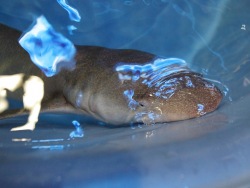The Primorsky Aquarium welcomes two large sharks

The Primorsky Aquarium has new additions to its collection - two tawny nurse sharks (Nebrius ferrugineus). The predators have arrived in Vladivostok from Indonesia. Now our biologists and fish pathologists are adapting the tropical residents to life in the Aquarium.
“In accordance with the general international practice of transporting large aquatic animals, they should be carried separately from each other, in individual containers filled with water and oxygen, and in the shortest possible time; the quicker animals are transported to their destination, the easier they adjust to a new environment”, said Maria Popova, Principal Fish Pathologist at the Primorsky Aquarium. “By world standards, transport time up to 20 hours is considered preferable, our sharks were 18 hours on the road and withstood their journey with minimal stress: the very next day the fish began taking food - they eagerly eat scallop and squid, and we have learned that they adore smelt”.
The acclimation procedures held for the tawny sharks by the Aquarium’s fish pathologists, among others, include freshwater bathing. This method is the simplest and safest way of treating aquatic animals brought from the wild for marine ectoparasites.
Both tawny nurse sharks are females of 2 to 3 years old, their length is about 1.5 meters.
“In terms of the species' lifespan they are teenagers,” said Mikhail Streltsov, Head of the Tropical Marine Organisms Department. “These two individuals are very curious: they watch people and are not afraid to raise their heads out of water. The tawny nurse shark is regarded as a species harmless to humans, nevertheless, its grip can be called “iron tight”: after seizing prey, a tawny shark will hardly release its jaws. Now our task is to teach the predators not to perceive their future tank mates as food items. We have started hand-feeding our “nurses”, and we are sure that they will quickly get accustomed to people. After that the newcomers will be placed in the Ocean Abyss tank, the largest one at the Aquarium, where the tawny nurse sharks will become full participants in the Dancing with Rays show.”
General information
—The tawny nurse shark is the only member of the genus Nebrius in the family Ginglymostomatidae.
—This species is widely distributed in coastal waters of the Indo-Pacific region.
—Its average length is between 2.2 and 3.7 meters, the largest reported specimen was 4 meters long.
—The tawny nurse shark is a benthic predator, whose diet consists of octopus, squid, cuttlefish, crustaceans, sea urchins, various small bony fishes and some other bottom-dwellers.
—To breathe, the tawny nurse shark uses its spiracles and buccal pump, which enable the fish to ventilate its gill apparatus and to lie still on the sea-floor for a long time. The pump also allows the predator to suck out the prey hiding in cracks and crevices.